The latest extension granted by the U.S. Department of Justice (DOJ) in its review of Alaska Airlines’ $1.9 billion acquisition of Hawaiian Airlines is more than just a procedural delay. Rather, it’s a glimpse into the intricate and ongoing negotiations that could define the future of this merger. The extension, which pushes the decision deadline to 12:01 AM ET on August 20, 2024 (6:01 PM Hawaii time on Monday), raises important questions about what’s really happening behind closed airline and government doors.
If the DOJ were poised to outright reject the merger, citing antitrust concerns, that decision would likely have been made and announced by now. The fact that we’re seeing repeated extensions rather than a clear “no” or the filing of a lawsuit against the acquisition, suggests that there’s more at play. Both Alaska and Hawaiian Airlines, along with DOJ officials, appear to be engaged in nuanced discussions aimed at addressing specific regulatory concerns. We will learn about them at the conclusion of these negotiations, and we’ve said previously those could be related to routes, including those from Seattle, assurances about interisland continuance, or other factors.
This extended dialogue indicates that the DOJ has significant reservations about Hawaiian deal’s completion.
But, at the same time, it says that the government isn’t entirely opposed to the idea either. Fascinating. If the merger were free of major defects, it would have likely been approved by now. On the other hand, the repeated delays imply that the DOJ together with the airlines, continue to see potential pathways to resolve DOJ concerns—provided the parties can agree on sufficient remedies.
These remedies would involve concessions by Alaska Airlines and Hawaiian Airlines to mitigate the DOJ’s antitrust concerns. This will include measures designed to ensure that the merger doesn’t reduce competition in a way that substantially harms consumers, particularly in our critical Hawaii market.
The backdrop to this Hawaiian/Alaska negotiation is the vigilant stance against airline mergers.
This was already demonstrated earlier this year, when the DOJ successfully blocked JetBlue’s $3.8 billion acquisition of Spirit Airlines. That case set a further precedent, indicating that the DOJ will step in to prevent deals it views as harmful to competition, and not pro-consumer.
For Alaska and Hawaiian, the stakes could not be higher.
The merger promises to create a stronger unified platform that could enhance competition with major airlines, potentially leading to lower fares and better service for consumers. There have been comments both in agreement and opposition to that premise.
For Alaska and Hawaiian Airlines, this combination also offers the prospect of increased stability, allowing them to pool all resources, expand routes, and invest more heavily in Hawaii operations.
However, these potential benefits must be weighed against the risks. Critics here and elsewhere have argued that the merger could reduce competition, particularly in the Hawaii market, where the two airlines together already have a dominant presence. This consolidation could thus lead to higher prices and fewer choices for travelers if not properly managed. Moreover, the integration of the two airlines’ operations and cultures poses its own set of challenges, with potential hiccups at least during the transition period.
As the clock ticks down once again today, the focus remains on whether these negotiations will lead to a compromise that satisfies the DOJ’s concerns—or if the deal will ultimately still be grounded. What’s clear is that the outcome of this extended review process will have significant implications for the future of both airlines and the broader Hawaii travel industry.
For more details on the ongoing developments, you can read our previous coverage.
BOH photo at event announcing intended acquisition of Hawaiian Airlines by Alaska Airlines.
Get Breaking Hawaii Travel News
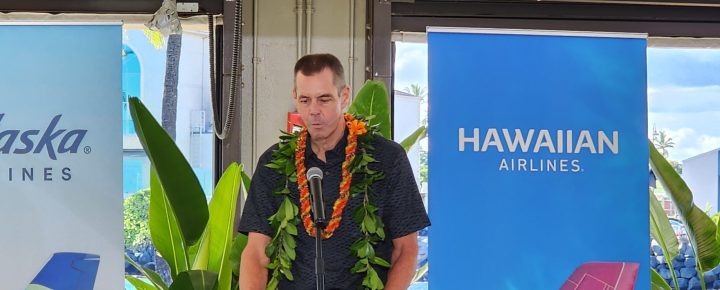
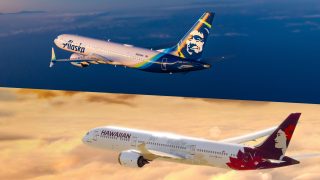


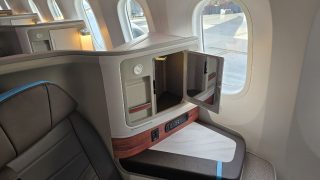
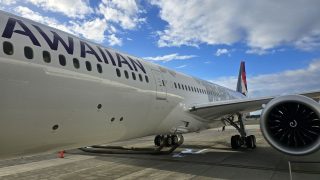
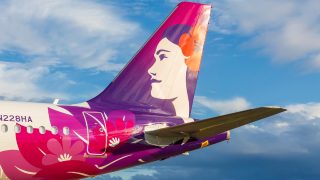
This merger has been years in the making and is more of a bailout than a strategic business move. Behind the scenes, HA had already started getting rid of its assets and laying off employees before the merger was announced. Whenever the leadership and management has made a bad decision or underperforms, the employees at the operational level face the consequences.
I cannot see how giving a leisure airline with higher operational costs a competitive advantage in the market will result in lower airfares for consumers. If anything, the competitive advantage will allow HA/Alaska to gain a bigger market share and raise or maintain their current fares which are higher than most.
I hope they don’t approve the merger between the two airlines !!!!
Hi Irita,
I totally agree with you. I hope this merger fails or denied.
My thoughts… Alaska will monopolize the whole airline industry.
Alaska airlines has US domestic, Mexico, Anchorage, Canada, Hawaii and soon International via Hawaiian Airlines and cargo. And with those new dream liner planes they can go magically more places and we don’t need monopoly in Hawai’i. I’m rooting for Southwest to be kept in Hawaii. Why Southwest because they don’t fly international routes besides Mexico and limited routes throughout US domestic.
Was HA bleeding 1mm a day when AK offered to buy them? Shouldn’t that be reflected in the price?
Looks like they are inching towards a resolution and hope they resolve whatever issues are sticking points get ironed out so a deal is completed. If history is any guide, look no further to the Alaska/Virgin Airlines merger where the One World Alliance with American airlines was restricted. The DOJ might require something similar.
I’m all for Hawaiian remaining there own Brand and serving our 50 State and non-contiguous State and it’s residents and tourism. Today’s worsening economy, recession and tge real threat of a Depression, would have Alaska (100% 737) controlling the traffic from the Pacific NW, while United in SF, Delta in LA/SLC, AA in LA and Southwest. Competitive Fares is not based on # of Airlines, but Market Demand, and a merger, will only enhance Alaska, but not contribute to lower Fares from other Markets! We saw what happened in 2021-2022 with constricted tourism that has never come back. Hawaiian must survive as an Independent Carrier.
But HA isn’t going to survive as an independent carrier. It’s bleeding money.
The airline will end up filing for chapter 11 protection in the near future if this merger doesn’t happen & it may quickly find that there is no debtor-in-possession financing available. Meaning the chapter 11 would convert to a chapter 7 and we’re now talking about the liquidation of all HA’s unencumbered assets. And, of course, all HA employees would be out of a job.
How does that benefit the state of Hawaii?
Where’s the evidence of a recession? Try to consume some journalism.
“Hawaii Seeks Broader Horizons as U.S. Travelers Tighten Wallets”-
BOH August 17th headline.
Walgrens closing 700 stores, Subway emergency franchise meeting, Home Depot sales down 4.7%; all reported August 16th.
Consume that.
You just got to see what as did to va in that merger to see what ha will look lke in cpl yrs ie completely gone as all airbus planrs now own by foriegn airlines. As will any chance of competive fares out of pnw esp sea. Ideally jal woldu be part of the deal maybe take over as sea slots to hi.
If approved its much higher fares on the death plane and hoping the door plug doesnt brust at 37000 ft.
Seattle to Hawaii isn’t slot restricted. Any airline that wants to fly the route can whenever they want to.
Not restricted by slots but is does appear that both SEA and HNL both assign gate space based on usage which might means there is a lack of additonal gate space for new entrants due to the heavy usage by AS/HA. However, if the DOJ trys to restrict either airline at either airport there would be a potential decrease in service. Not sure how that gets fixed.
I’m pretty sure the minimum usage only affects being able to have exclusive use of a particular gate. Not meeting the minimum usage would simply mean an airline could be assigned different gates for different flights. But it wouldn’t limit gates.
Thanks for reporting on this, I’m eagerly awaiting the outcome.